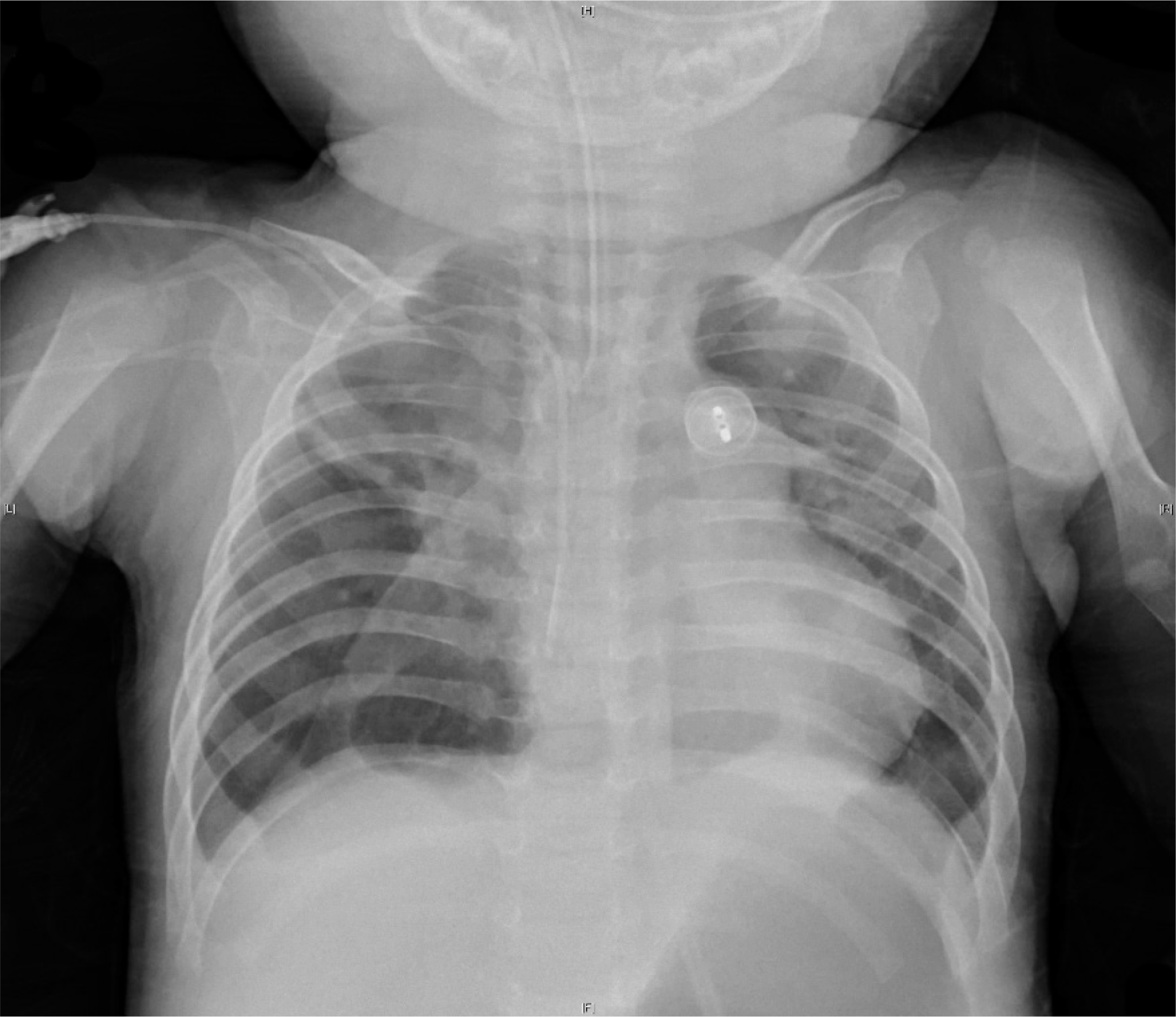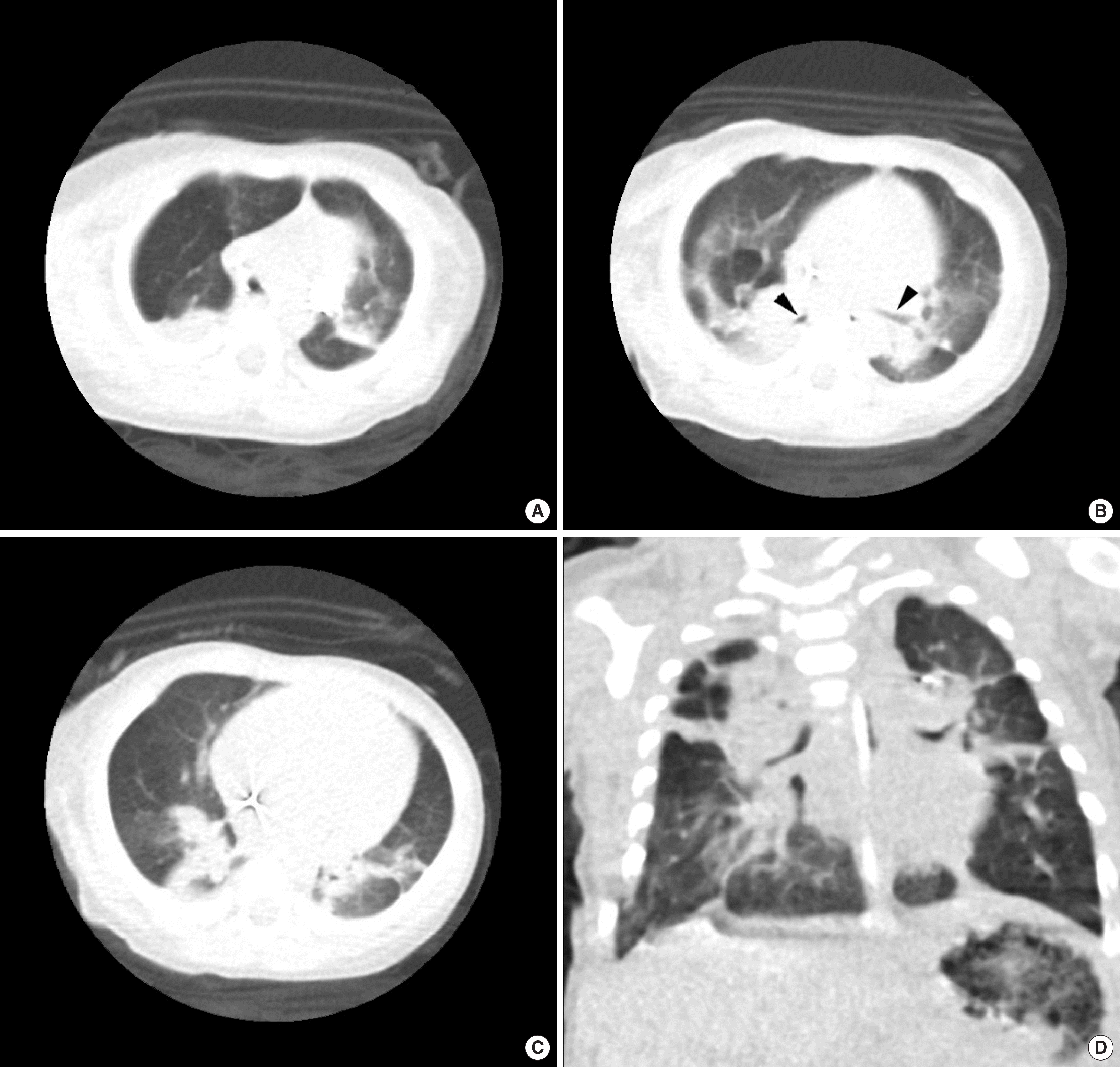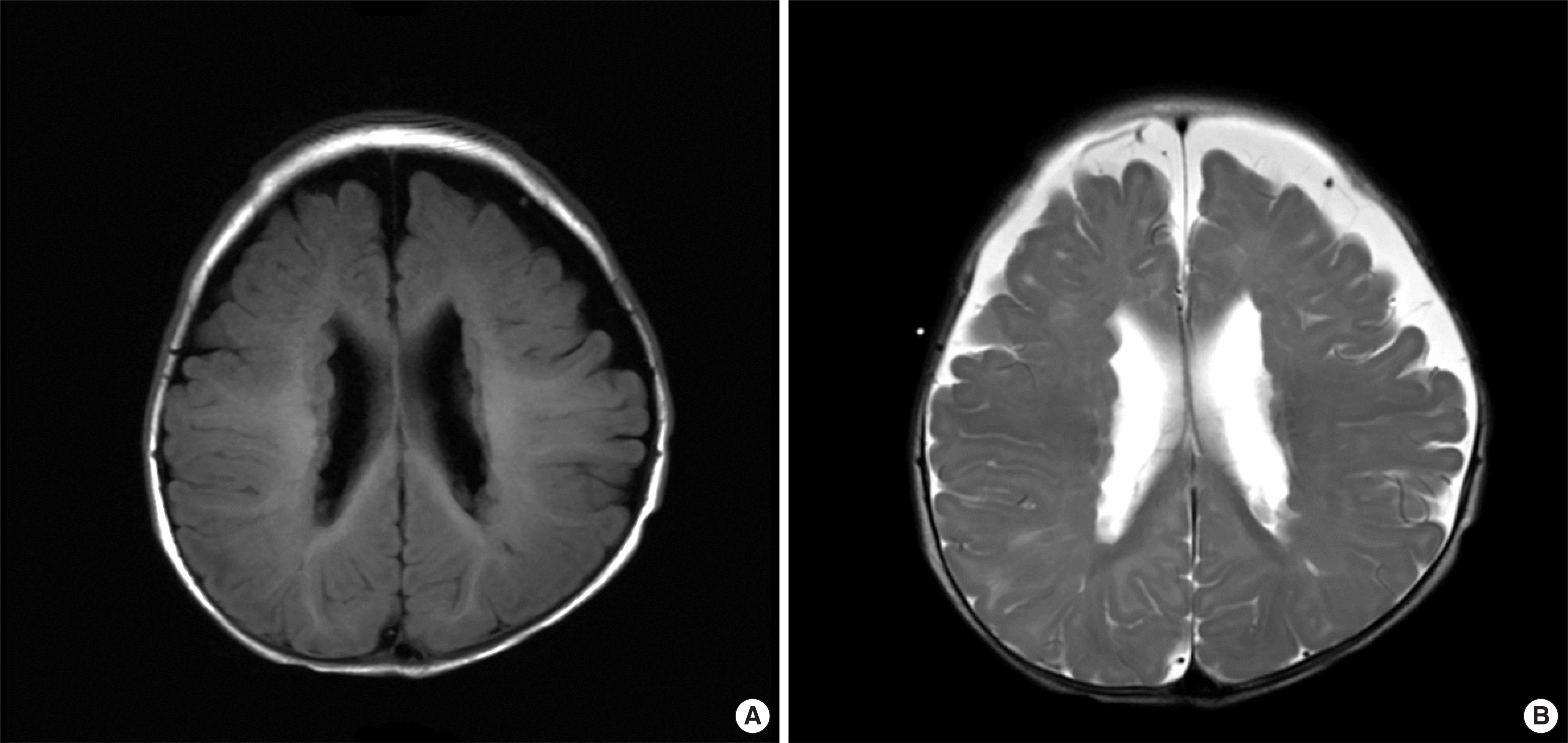Abstract
Filamin A is an actinbinding protein and, in humans, is encoded by FLNA gene in the long arm of X chromosome. Filamin A plays a role in the formation of cytoskeleton by crosslinking actin filaments in cytoplasm. FLNA mutations affect cytoskeletal regulatory processes and cellular migrating abnormalities that result in periventricular heterotopia. A 5-month-old girl was hospitalized because of breathing difficulty and was diagnosed as having periventricular heterotopia with laryngomalacia, cricopharyngeal incoor-dination, pulmonary hypertension, and chronic lung disease. A genetic test was performed to find the cause of periventricular heterotopia, and FLNA gene mutation (c.5998+1G>A) was confirmed for the first time in Korea. After discharge, she developed respiratory failure due to a viral infection at 8 months of her age. In spite of management with mechanical ventilation, she died of pneumothorax and pulmonary hemorrhage. Herein, we report a case of FLNA gene mutation who presented with periventricular nodular heterotopia with respiratory insufficiency.
Go to : 
References
1. Hartwig JH, Stossel TP. Isolation and properties of actin, myosin, and a new actinbinding protein in rabbit alveolar macrophages. J Biol Chem. 1975; 250:5696–705.

2. Sheen VL, Dixon PH, Fox JW, Hong SE, Kinton L, Sisodiya SM, et al. Mutations in the X-linked filamin 1 gene cause periventricular nodular heterotopia in males as well as in females. Hum Mol Genet. 2001; 10:1775–83.

3. Fox JW, Lamperti ED, Ekşioğlu YZ, Hong SE, Feng Y, Graham DA, et al. Mutations in filamin 1 prevent migration of cerebral cortical neurons in human periventricular heterotopia. Neuron. 1998; 21:1315–25.

4. Cunningham CC, Gorlin JB, Kwiatkowski DJ, Hartwig JH, Janmey PA, Byers HR, et al. Actinbinding protein requirement for cortical stability and efficient locomotion. Science. 1992; 255:325–7.

5. Lange M, Kasper B, Bohring A, Rutsch F, Kluger G, Hoffjan S, et al. 47 patients with FLNA associated periventricular nodular heterotopia. Or-phanet J Rare Dis. 2015; 10:134.

6. Singh S, Schecter MG, Guillerman RP, Baker ML, Mallory GB. Case series of four infants with severe infantile respiratory failure associated with filamin A mutation leading to lung transplantation [abstract]. In: American Thoracic Society 2013 International Conference; 2013 May 19; Pennsylvania, USA. Pennsylvania (PA): Am J Respir Crit Care Med. 2013.
7. Masurel-Paulet A, Haan E, Thompson EM, Goizet C, Thauvin-Robinet C, Tai A, et al. Lung disease associated with periventricular nodular heterotopia and an FLNA mutation. Eur J Med Genet. 2011; 54:25–8.

8. de Wit MC, Tiddens HA, de Coo IF, Mancini GM. Lung disease in FLNA mutation: confirmatory report. Eur J Med Genet. 2011; 54:299–300.

9. Lord A, Shapiro AJ, Saint-Martin C, Claveau M, Melançon S, Wintermark P. Filamin A mutation may be associated with diffuse lung disease mimicking bronchopulmonary dysplasia in premature newborns. Respir Care. 2014; 59:e171–7.

10. Eltahir S, Ahmad KS, Al-Balawi MM, Bukhamsien H, Al-Mobaireek K, Alotaibi W, et al. Lung disease associated with filamin A gene mutation: a case report. J Med Case Rep. 2016; 10:97.

11. Shelmerdine SC, Semple T, Wallis C, Aurora P, Moledina S, Ashworth MT, et al. Filamin A (FLNA) mutation-A newcomer to the childhood interstitial lung disease (ChILD) classification. Pediatr Pulmonol. 2017; 52:1306–15.

12. Bickel S, Siefman M, Eid NS. Interstitial lung disease, bronchiectasis, and asthma in a patient with filamin A, alpha (flna) mutation [abstract]. In: American Thoracic Society 2015 International Conference; 2015 May 20; Debver, USA. Debver (CO): Am J Respir Crit Care Med. 2015.
13. Hehr U, Hehr A, Uyanik G, Phelan E, Winkler J, Reardon W. A filamin A splice mutation resulting in a syndrome of facial dysmorphism, periventricular nodular heterotopia, and severe constipation reminiscent of cere-bro-fronto-facial syndrome. J Med Genet. 2006; 43:541–4.

14. Poussaint TY, Fox JW, Dobyns WB, Radtke R, Scheffer IE, Berkovic SF, e al. Periventricular nodular heterotopia in patients with filamin-1 gene mutations: neuroimaging findings. Pediatr Radiol. 2000; 30:748–55.

15. Robertson SP, Twigg SR, Sutherland-Smith AJ, Biancalana V, Gorlin RJ, Horn D, et al. Localized mutations in the gene encoding the cytoskeletal protein filamin A cause diverse malformations in humans. Nat Genet. 2003; 33:487–91.

16. Chen CP, Chern SR, Chiu NC, Liu YP, Chen YN, Chen SW, et al. Detection of a novel c.7106_7110delinsT heterozygous mutation in the FLNA gene in an asymptomatic mother with periventricular nodular heterotopia during prenatal genetic counseling. Taiwan J Obstet Gynecol. 2016; 55:897–9.

17. Loo DT, Kanner SB, Aruffo A. Filamin binds to the cytoplasmic domain of the beta1-integrin. Identification of amino acids responsible for this interaction. J Biol Chem. 1998; 273:23304–12.
18. Zhang W, Gunst SJ. Interactions of airway smooth muscle cells with their tissue matrix: implications for contraction. Proc Am Thorac Soc. 2008; 5:32–9.

19. Reinstein E, Frentz S, Morgan T, García-Miñaúr S, Leventer RJ, McGilli-vray G, et al. Vascular and connective tissue anomalies associated with X-linked periventricular heterotopia due to mutations in Filamin A. Eur J Hum Genet. 2013; 21:494–502.

20. Hayashi K, Altman A. Filamin A is required for T cell activation mediated by protein kinase C-theta. J Immunol. 2006; 177:1721–8.
Go to : 
 | Fig. 1.Chest X-ray of the patient. Anteroposterior view shows atelectasis of both upper lung fields. |
 | Fig. 2.Chest computed tomography (CT) of the patient. Axial view of upper (A), middle (B), lower (C) zones, and coronal view (D) show hyperinflation in both upper lobes and right middle lobe. Multifocal subsegmental atelectasis is also present in both lower lobes. Narrowing of the both bronchi (arrow heads) suggests bronchomalacia. |
 | Fig. 3.Brain magnetic resonance image scan of the patient. T1 (A) and T2 (B) axial planes show bilateral periventricular nodular heterotopia. |
 | Fig. 4.Electropherogram of FLNA gene sequences of the patient and her parents. The patient and her mother are found to have heterozygous mutation of FLNA gene (c.5998+1G>A). |
Table 1.
A summary of previous FLNA gene mutation cases




 PDF
PDF ePub
ePub Citation
Citation Print
Print


 XML Download
XML Download